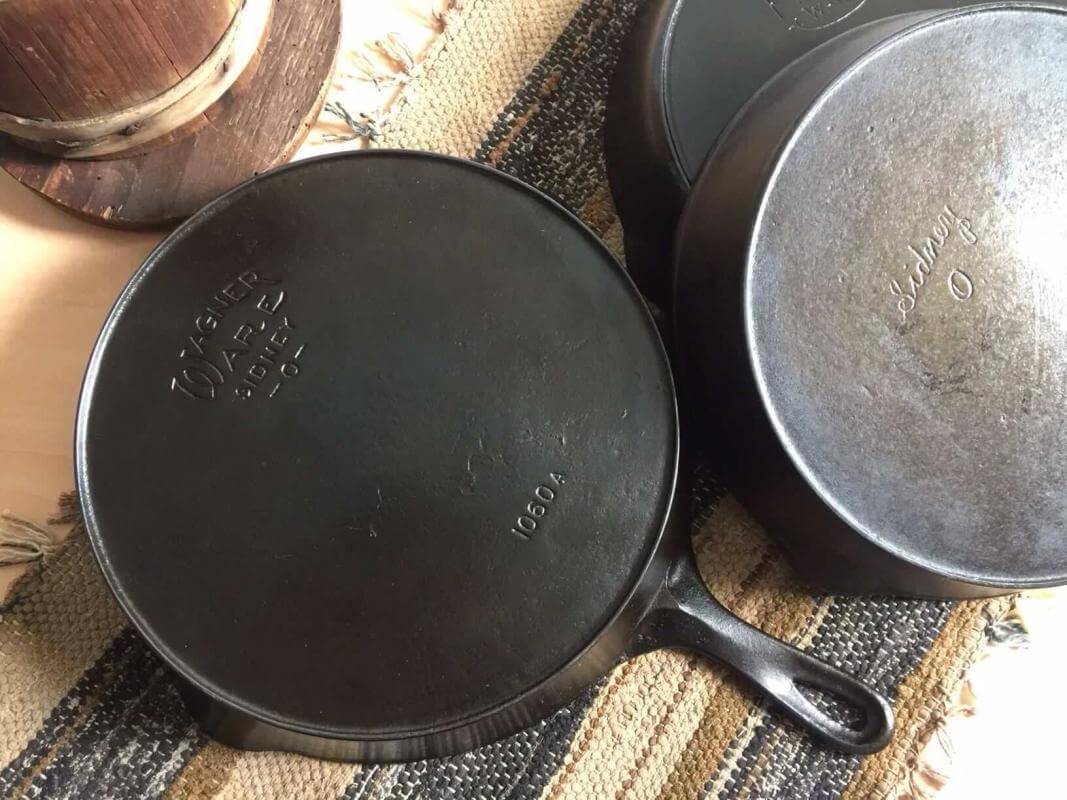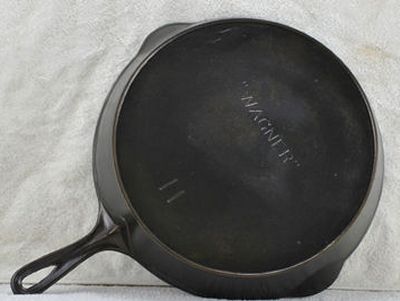Dating wagner cast iron skillets
Leave a comment below — I would love to hear your thoughts. I hear the question all the time: How old is my Wagner cast iron skillet? Is there a way to date my Wagner cast iron dutch oven? Or even my Griswold skillet? It is not an easy answer and there are a few factors to consider. So, first off there is a line of demarcation for collectible cast iron cookware.
- Dating wagner cast iron;
- Dating Wagner Cast Iron - Wagner Cast Iron Skillet.
- Wagner Cast Iron Skillet - Dedicated to Cast Iron.
- 7 minute dating nj.
- weird dating advice.
- Dating wagner cast iron – AERO CONTROLS, INC..
- Dedicated to Cast Iron.
I would say the s — early s made cast iron cookware is still pretty darn good and probably some of those pieces are better than what you can get today. In many cases, we cannot determine the exact date that a piece of cookware was made. We can come pretty close to a range of dates once we understand a little bit about the manufacturing of the cookware.
The iron foundries would have moulds for the various pieces of cookware and over time the moulds would need to be replaced. Or through expansion the foundries would get more moulds to increase production or to make another piece of cookware. Why is all this is important? Well, the logos and markings on the bottom and handles of cookware would change over time.
In this way, we can assume within a range when a piece of cookware was actually made.
The two pieces to the right which I found on ebay , are most likely from the period from — And one of them, the 3 was apparently never used. When I got it, there was a little bit of rust present on the gray, unseasoned, raw cast iron. Amazing that it never had any food on it until I bought it. After that I seasoned it using the method outlined here. One of the best ways to tell is by the font, location, and styling of the logo and trademarks on the bottom of the cookware.
I highly recommend checking out castironcollector. I used the photos there to review the font and location of the logo on the bottom of the skillet. The logo and writing is in the center near the top, or opposite the handle. The guide at castironcollector. Well, the good folks at Lodge know all about this issue.
They now carry Silicone Handle Covers. One key thing to keep in mind is this is a one-size-fits all kind of product and in my opinion Lodge should have, maybe, offered a couple other sizes. The smaller skillets, like a 6. Please keep this in mind and this trade off makes this handle cover favorable over a cloth cover.
The other great accessory is the Lodge Polycarbonate Pan Scraper.
Directions
This little tool allows you to clean your cast iron cookware well without using soap or compromising the sought after non-stick seasoning. The polycarbonate material is strong and hard enough to allow all the food remnants to be scraped away yet the scraper will not scratch up your cast iron. The scrapers come in a pack of 2 and can be used for all your cast iron cookware. One of the key features is that each of the corners on the scraper is shaped differently, allowing you to clean every nook and cranny of your cookware. In our previous post , we mentioned that really any type of fat will work, with vegetable oil or shortening being the most commonly used due to their near-ubiquitous presence in modern kitchens.
However, in the past few years, rumors of excellent cast iron seasons using flaxseed oil have caught our ears, and we were anxious to try it out. If you have not yet tried to totally strip and re-season a piece of cast iron, please consider the process…and check out this other post to provide some context about the process, benefits, and why one may consider stripping the existing seasoning.
- free dating site in europe 2020.
- lol you have been removed from the matchmaking queue.
- speed dating muncie in.
- Dating Wagner Cast Iron;
- carbon dating procedure.
- 100 free dating site belgium.
Flax is a flowering plant the blooms are blue that grows in the cooler part of the Northwestern United States and Western Canada. These are the same heart-healthy fatty acids promoted by cardiologists and dietitians found in fish and nuts and flax seed. Interestingly, these same fatty acids apparently provide an extremely tough and slick seasoning layer when they polymerize to form the seasoning layer on the surface of cast iron.
The upshot of this is that you can find flaxseed oil pretty easily in the health-food section of your local megamart.
How To Restore Cast Iron
No worries, once polymerized by the heat, the oil will form a smooth, non-reactive surface and the fishy smell will disappear. You might consider doing this on the grill if you have a command of temperature control or you have some hot coals smoldering from grilling some meat.
There are many guides on how to season cast iron cookware. Preheat oven to degrees Fahrenheit. Once preheated, place cookware into oven for 15 minutes.
Remove cookware from oven, turn oven off, and open the door to let it cool down as much as possible. Be sure to get every nook and cranny, inside and outside. Using a second paper towel, wipe as much excess oil off of the surface as possible. Put the cookware upside down into the semi cool oven. Once the oven reaches this temperature, leave the cookware inside for 1 hour.

After 1 hour, turn the oven off and let cool completely with the cookware inside. Repeat Steps at least 5 times, or until a smooth, black season is obtained. Luckily, after the first coat is applied, the danger of rust is past and you can apply the other coats over a few days. The more you use it, the better! One of the main reasons why people choose a cast iron skillet for their cooking tasks is because cast iron cookware can be used for almost anything. Whether you want to sear potatoes, bake a cake or stir-fry vegetables, one cast iron frying pan is all you need.
However, because cast iron cooking can be a lot of fun, especially for someone new to the idea, you may find yourself with more than just a single pan. Here are some other reasons why you may consider cooking with cast iron:. Unlike most non-stick pans on which you need to use rubber spatulas or special spoons to cook the food, you can use metal spatulas, rakes, shovels or nearly anything on cast iron.
- .
- online dating course.
- dating nepalese girl.
- .
It truly is virtually indestructible. Many traditional pots and pans can lose their shape, as exposure to heat and use over time molds the shape of the pan, yet cast iron continues to look exactly the same. Cast iron skillets hold flavor for longer. Many maintain that the flavors are held within the pan itself, so when you cook something new, you are still adding a little bit of the flavors that were there previously.
For better or worse, cooking with cast iron can ensure a different flavor experience each and every time. Cast iron skillets are ideal heat conductors.

They have high heat retention, and those who swear by cast iron maintain that the food heats more evenly when compared to traditional pots and pans. The versatility of a cast iron skillet is unrivaled; you can use it on a stove, on a barbecue grill or even in your oven. Cast iron can be preheated to temperatures that will brown meat and will withstand higher oven temperatures than what is considered safe for traditional non-stick pans.
Because cast iron skillets hold heat for longer periods of time and heat up more quickly, you actually save a little bit of money in electric or gas heating costs, whichever applies to your home. One of the main reasons people enjoy cooking with cast iron is that it is versatile — you can use these pans for baking, stir-frying, searing and boiling. In fact, before the slow cooker ever existed, grandmothers around the world used cast iron Dutch ovens for all of their cooking. Dutch ovens, used for hundreds of years, are notorious for cooking if you want an even temperature. Moreover, a Dutch oven can go from stovetop to oven without missing a beat.
If you do not currently own a cast iron frying pan, it is well-worth your time and money to invest in the cookware. You can often find sales on the Internet, and most stores carrying cast iron skillets that are pre-seasoned and ready to use. Remember that cast iron can last for three generations or longer. Anyone who is anyone in the cooking world knows and appreciates the importance of a good cast iron skillet.
While you may worry that because these have already been used, they are disgusting and not worth the dollar you might spend, cleaning cast iron is relatively simple. Iron deficiency is fairly common across the globe, particularly in women. As many as one in 10 American women do not receive adequate amounts of iron; if you are looking for a different way to add iron into your diet other than taking a vitamin or supplement, cooking food, especially an acidic food like tomato sauce, in a cast iron frying pan can increase the iron content by as much as 20 times.
Did you know that cast iron frying pans are also healthier than non-stick pans? The lovely sheen that you see in the skillet is the sign of a well-used and well-seasoned pan, which translates into non-stick as well. Fortunately, however, you will not need to use heaping amounts of oil to sear chicken or brown crispy potatoes while cooking with cast iron.